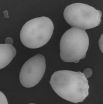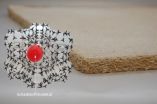(Press-News.org) A strange, glowing green cloud of gas that has mystified astronomers since its discovery in 2007 has been studied by Hubble. The cloud of gas is lit up by the bright light of a nearby quasar, and shows signs of ongoing star formation.
One of the strangest space objects ever seen is being scrutinised by the penetrating vision of the NASA/ESA Hubble Space Telescope. A mysterious, glowing green blob of gas is floating in space near a spiral galaxy. Hubble uncovered delicate filaments of gas and a pocket of young star clusters in the giant object, which is the size of the Milky Way.
The Hubble revelations are the latest finds in an ongoing probe of Hanny's Voorwerp (Hanny's Object in Dutch). It is named after Hanny van Arkel, the Dutch schoolteacher who discovered the ghostly structure in 2007 while participating in the online Galaxy Zoo project. Galaxy Zoo enlists the public to help classify more than a million galaxies catalogued in the Sloan Digital Sky Survey. The project has expanded to include Galaxy Zoo: Hubble, in which the public is asked to assess tens of thousands of galaxies in deep imagery from the Hubble Space Telescope.
In the sharpest view yet of Hanny's Voorwerp, Hubble's Wide Field Camera 3 and Advanced Camera for Surveys have uncovered star birth in a region of the green object that faces the spiral galaxy IC 2497, located about 650 million light-years from Earth. Radio observations have shown an outflow of gas arising from the galaxy's core. The new Hubble images reveal that the galaxy's gas is interacting with a small region of Hanny's Voorwerp, which is collapsing and forming stars. The youngest stars are a couple of million years old.
The greenish Voorwerp is visible because a searchlight beam of light from the galaxy's core has illuminated it. This beam came from a quasar — a bright, energetic object that is powered by a black hole. The quasar is thought to have turned off less than 200 000 years ago.
Astronomer Bill Keel of the University of Alabama in Tuscaloosa, USA, leader of the Hubble study, is presenting his results on this object today at the American Astronomical Society meeting in Seattle, USA. Read more about his preliminary findings in the NASA news release linked below.
INFORMATION:
Notes
The Hubble Space Telescope is a project of international cooperation between ESA and NASA.
Image credit: NASA, ESA, William Keel (University of Alabama, Tuscaloosa), and the Galaxy Zoo team
Links
NASA news release: http://hubblesite.org/newscenter/archive/releases/2011/01
Images of Hubble: http://www.spacetelescope.org/images/archive/category/spacecraft/
Hanny van Arkel's blog: http://www.hannysvoorwerp.com/
Galaxy Zoo: http://www.galaxyzoo.com/
Hubble zooms in on a space oddity
2011-01-11
ELSE PRESS RELEASES FROM THIS DATE:
New hope in fight against Huntington's disease
2011-01-11
Hope for new ways of treating devastating neurodegenerative disorders such as Huntington's disease has been raised by a trans-Atlantic team of researchers thanks to the use of cutting-edge genetic techniques.
Led by the University of Leicester, scientists from the University of Lisbon (led by Dr Tiago Outeiro) and University of California at San Francisco (led by Dr Paul Muchowski) collaborated to generate novel approaches for tackling the diseases. Their work, funded by the Medical Research Council, is published in The Journal of Biological Chemistry.
At Leicester, ...
New research shows how light can control electrical properties of graphene
2011-01-11
New research published today, shows how light can be used to control the electrical properties of graphene, paving the way for graphene-based optoelectronic devices and highly sensitive sensors.
This year's Nobel Prize for Physics was awarded for research into graphene, recognising its potential for many applications in modern life, from high-speed electronics to touchscreen technology. The UK's National Physical Laboratory, along with a team of international scientists, have further developed our understanding of graphene by showing that when this remarkable material ...
Researchers uncover behavioral process anticipating the results of rapid eye movements
2011-01-11
A team of researchers has demonstrated that the brain predicts consequences of our eye movements on what we see next. The findings, which appear in the journal Nature Neuroscience, have implications for understanding human attention and applications to robotics.
The study was conducted by researchers at University Paris Descartes, New York University's Department of Psychology, and Ludwig-Maximilian University in Munich.
Our eyes jump rapidly about three times each second to capture new visual information, and with each jump a new view of the world falls onto the retina—a ...
Federal peer review may be overstretched and error prone
2011-01-11
The federal peer review system, by which research proposals are judged worthy for funding, may be "over stretched" and "susceptible to error," said Elmer Yglesias, a researcher at the Science and Technology Policy Institute and author of "Improving Peer Review in the Federal Government," published in the current issue of TECHNOLOGY & INNOVATION, Proceedings of the National Academy of Inventors ™, (www.academyofinventors.org) now available on-line at: http://www.cognizantcommunication.com/filecabinet/Technology/techinnovation.html
According to Yglesias, the federal ...
Radiometer finds sources of fire
2011-01-11
The number and scale of forest fires has increased dramatically in recent decades. Who can forget last summer's television images of blazing infernos devouring miles and miles of forest in Russia, Australia and California? In Germany, too, several regions are under threat precipitated by climate change – Brandenburg, for example, is one of the areas of Europe that are most at risk.
Often, fires can only be contained from the air. In order to fight them in a targeted way, firefighting planes need to be given precise information on where the flames are at their worst. Infrared ...
No left turn: 'Superstreet' traffic design improves travel time, safety
2011-01-11
The so-called "superstreet" traffic design results in significantly faster travel times, and leads to a drastic reduction in automobile collisions and injuries, according to North Carolina State University researchers who have conducted the largest-ever study of superstreets and their impacts.
Superstreets are surface roads, not freeways. It is defined as a thoroughfare where the left-hand turns from side streets are re-routed, as is traffic from side streets that needs to cross the thoroughfare. In both instances, drivers are first required to make a right turn and ...
Researchers create 'scoring system' for PTEN mutation testing
2011-01-11
Monday, January 10, 2011 – Cleveland – Researchers have discovered a method for more precise identification of individuals who should undergo testing for genetic mutations of the tumor suppressor gene PTEN, which associates with a variety of conditions including several types of cancers. The research has created a diagnostic scoring system that improves on established criteria.
Led by Charis Eng, M.D., Ph.D., Chair of the Genomic Medicine Institute at the Lerner Research Institute of Cleveland Clinic, the study – the largest clinical study to date on the identification ...
Minerals provide better indoor air
2011-01-11
Since the 50s, formaldehyde has been the basic material for many artificial resins and glues used in particleboards and plywood boards. Estimates indicate that more than 85 percent of all wood materials have adhesives containing formaldehyde. This substance escapes from the materials and, along with other sources, pollutes indoor air. This is why numerous ways have been developed to reduce emissions, and the International Agency for Research on Cancer (IARC) of the World Health Organization WHO has even classified formaldehyde as carcinogenic for humans. Thereupon both ...
Social class and changes in mortality from liver cirrhosis over the 20th Century
2011-01-11
A paper describing a dramatic change during the 20th century in England and Wales in the association between social class and mortality from liver cirrhosis features in Alcohol and Alcoholism. While deaths from cirrhosis were more common among higher social classes in the early part of the century, the pattern changed so that deaths from cirrhosis were much more common among the lower social classes by the end of the century. Data on male cirrhosis mortality by social class were obtained from the Registrar General's Decennial Supplements for the years 1921�.
The ...
Researchers show how Alzheimer's plaques lead to loss of nitric oxide in brain
2011-01-11
PITTSBURGH, Jan. 10 – A researcher at the University of Pittsburgh School of Medicine, in collaboration with scientists from the National Institutes of Health (NIH), has discovered that the deadly plaques of Alzheimer's disease interact with certain cellular proteins to inhibit normal signals that maintain blood flow to the brain. Their findings, which could lead to new approaches to treat the dementia, were recently published in Public Library of Science One.
Levels of nitric oxide (NO) – a signaling molecule that helps regulate blood flow, immune and neurological processes ...




